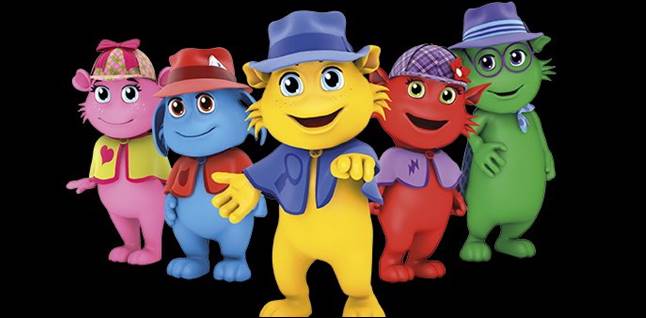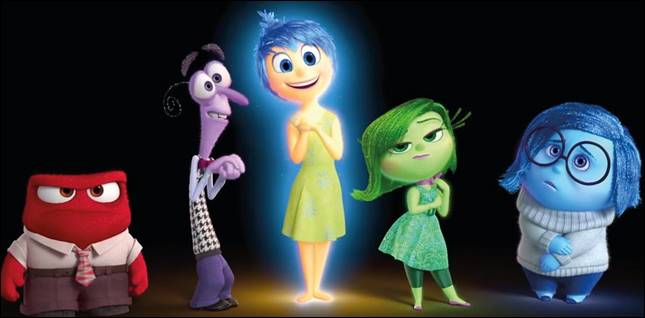 Daniels is an expert on children’s emotional intelligence and development. She designed and promoted initiatives that help children cope with strong emotions like loss and trauma. The Moodsters were devised as a commercial application of this work. Daniels hired a team to produce and develop her idea under the umbrella of her new company, The Moodsters Company.
Daniels is an expert on children’s emotional intelligence and development. She designed and promoted initiatives that help children cope with strong emotions like loss and trauma. The Moodsters were devised as a commercial application of this work. Daniels hired a team to produce and develop her idea under the umbrella of her new company, The Moodsters Company.
The initial product was The Moodsters Bible (“Bible”), a pitchbook released in 2005. It provided a concise way to convey Daniels’s idea to media executives and other potential collaborators, and included a brief description of the characters, themes, and setting that Daniels envisioned for her Moodsters universe.
The Moodsters are five characters that are color-coded anthropomorphic emotions, each representing a different emotion: pink (love); yellow (happiness); blue (sadness); red (anger); and green (fear). Daniels initially named The Moodsters Oolvia, Zip, Sniff, Roary, and Shake, although these names changed in each iteration of the characters.
Daniels and The Moodsters Company pitched The Moodsters to numerous media and entertainment companies. One recurring target was The Walt Disney Company and its affiliates, including Pixar. Daniels alleges that she or a member of her team had contact with several different Disney employees between 2005 and 2009.
 Disney began development of its movie Inside Out in 2010. The movie was released in 2015, and centers on five anthropomorphized emotions that live inside the mind of an 11-year-old girl named Riley. Those emotions are joy, fear, sadness, disgust, and anger. Docter, who directed and co-wrote the screenplay, stated that his inspiration for the film was the manner with which his 11-year-old daughter dealt with new emotions as she matured.
Disney began development of its movie Inside Out in 2010. The movie was released in 2015, and centers on five anthropomorphized emotions that live inside the mind of an 11-year-old girl named Riley. Those emotions are joy, fear, sadness, disgust, and anger. Docter, who directed and co-wrote the screenplay, stated that his inspiration for the film was the manner with which his 11-year-old daughter dealt with new emotions as she matured.
Daniels filed suit against Disney in 2017 for breach of an implied-in-fact contract, arising from Disney’s failure to compensate Daniels for the allegedly disclosed material used to develop Inside Out. Daniels then filed an amended complaint, joining The Moodsters Company as a co-plaintiff and alleging copyright infringement of both the individual Moodsters characters and the ensemble of characters as a whole.
Disney filed a motion to dismiss, asserting that Daniels failed to meet the legal standard for copyright in a character, and that the copyright “publication” of the Bible and pilot doomed Daniels’s implied-in-fact contract claim.
The district court granted Disney’s motion to dismiss, and granted Daniels leave to file an amended complaint on the copyright claims. Disney filed a motion to dismiss the Amended Complaint, which the district court granted on the ground that The Moodsters are not protectable by copyright.
Copyright Protection for The Moodsters
Although characters are not an enumerated copyrightable subject matter under the Copyright Act, there is a long history of extending copyright protection to graphically-depicted characters. However, “not every comic book, television, or motion picture character is entitled to copyright protection.”
A character is entitled to copyright protection if (1) the character has “physical as well as conceptual qualities,” (2) the character is “sufficiently delineated to be recognizable as the same character whenever it appears” and “displays consistent, identifiable character traits and attributes,” and (3) the character is “especially distinctive” and “contains some unique elements of expression.”
Application of the Towle Test to The Moodsters
Disney does not dispute that the individual Moodster characters meet the first prong of the Towle test: each has physical as well as conceptual qualities. Because they have physical qualities, The Moodsters are not mere literary characters.
The second prong presents an insurmountable hurdle for Daniels. Towle requires that a character must be “sufficiently delineated to be recognizable as the same character whenever it appears.” Although a character that has appeared in multiple productions or iterations “need not have a consistent appearance,” it “must display consistent, identifiable character traits and attributes” such that it is recognizable whenever it appears.
Consistently recognizable characters like Godzilla or James Bond, whose physical characteristics may change over various iterations, but who maintain consistent and identifiable character traits and attributes across various productions and adaptations, meet the test. By contrast, a character that lacks a core set of consistent and identifiable character traits and attributes is not protectable, because that character is not immediately recognizable as the same character whenever it appears.
The notion of using a color to represent a mood or emotion is an idea that does not fall within the protection of copyright. So it is no surprise that the idea of color psychology is involved in everything from decorating books to marketing and color therapy. Color and emotion are also frequent themes in children’s books.
Notably, colors themselves are not generally copyrightable. “Color by itself is not subject to copyright protection. “Mere variations of coloring” are not copyrightable. Nor is the “idea” of an emotion copyrightable. Taken together, these principles mean that Daniels cannot copyright the idea of colors or emotions, nor can she copyright the idea of using colors to represent emotions where these ideas are embodied in a character without sufficient delineation and distinctiveness.
The physical appearance of The Moodsters changed significantly over time. In the 2005 Bible and 2007 television pilot, the five Moodsters have an insect-like appearance, with skinny bodies, long ears, and tall antennas that act as “emotional barometers” to form a distinctive shape and glow when an emotion is strongly felt.
By the second generation of toys, The Moodsters look like small, loveable bears. They are round and cuddly, have small ears, and each dons a detective’s hat and small cape. This physical transformation over time was not insubstantial, and it would be difficult to conclude that the 2005 Moodsters are the same characters as those sold at Target in 2015. “Lightly sketched” characters, without identifiable character traits, are not copyrightable under the second prong of Towle.
While a change of name was not dispositive in court’s analysis, these changes across the three iterations further illustrate that Daniels never settled on a well-delineated set of characters beyond their representation of five human emotions. Beyond the emotion it represents, each Moodster lacks comparable identifiable and consistent character traits and attributes across iterations, thus failing the second prong of the Towle test.
The Moodsters fail the third prong – they are not “especially distinctive” and do not “contain some unique elements of expression.” Daniels identifies The Moodsters as unique in that they each represent a single emotion. But this facet is not sufficient to render them “especially distinctive,” particularly given their otherwise generic attributes and character traits.
Developing a character as an anthropomorphized version of a specific emotion is not sufficient, in itself, to establish a copyrightable character. Taken together, The Moodsters are not “especially distinctive,” and do not meet the third prong of the Towle test. The district court did not err in dismissing Daniels’s claims for copyright infringement.
There is no dispute that the 2005 Moodsters Bible and the 2007 pilot television episode are protected by copyright. But Daniels cannot succeed on her copyright claim for The Moodsters characters, which are “lightly sketched” and neither sufficiently delineated nor representative of the story being told.